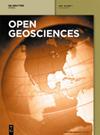Addressing incomplete tile phenomena in image tiling: Introducing the grid six-intersection model
IF 1.3
4区 地球科学
Q3 GEOSCIENCES, MULTIDISCIPLINARY
引用次数: 0
Abstract
With the continuous development of Earth Observation technology, resolution of imagery and gridded data has significantly increased, leading to a rapid increase in data volume. To efficiently acquire and analyze these vast amounts of imagery and gridded data, image tiling technology has been developed to effectively access data of interested areas. Tiling technology divides large-scale image data into smaller tiles, providing fast, accurate, and efficient access support for imagery and gridded data. The spatial grid model, as the foundational framework of the new generation of geographic spatial information, plays a critical role in the retrieval, integration, services, and applications of imagery and gridded data resources. When tiling image data based on the spatial grid model, it always generates both complete and incomplete tiles. Particularly, when conducting image tile retrieval using the same rule-based grid in the retrieval area, incomplete tile phenomena along the boundary regions of the retrieved images often occur, resulting in gaps within the retrieval area. To tackle this issue, in this study, we present a new topological model called the Grid Six-Intersection Model (G-6IM), specifically designed for regular rectangular grids, to accurately represent boundary issues in image tiling. Through a practical case study, we demonstrate the effectiveness and practical application potential of the proposed G-6IM model, providing new insights and guidance for the improvement and optimization of imagery and gridded data tiling technology.解决图像平铺中的不完整平铺现象:引入网格六交点模型
随着地球观测技术的不断发展,图像和网格数据的分辨率大幅提高,导致数据量迅速增加。为了有效获取和分析这些海量图像和网格数据,人们开发了图像平铺技术,以有效获取感兴趣区域的数据。平铺技术将大规模图像数据分割成小块,为快速、准确、高效地获取图像和网格数据提供了支持。空间网格模型作为新一代地理空间信息的基础框架,在影像和网格数据资源的检索、整合、服务和应用中发挥着至关重要的作用。在基于空间网格模型对影像数据进行平铺时,总会产生完整和不完整的平铺。特别是在检索区域内使用相同规则的网格进行图像瓦片检索时,往往会出现检索图像边界区域的瓦片不完整现象,导致检索区域内出现空白。为了解决这个问题,我们在本研究中提出了一种新的拓扑模型,称为网格六交集模型(G-6IM),专门为规则矩形网格设计,以准确表示图像平铺中的边界问题。通过实际案例研究,我们证明了所提出的 G-6IM 模型的有效性和实际应用潜力,为改进和优化图像和网格数据平铺技术提供了新的见解和指导。
本文章由计算机程序翻译,如有差异,请以英文原文为准。
求助全文
约1分钟内获得全文
求助全文
来源期刊

Open Geosciences
GEOSCIENCES, MULTIDISCIPLINARY-
CiteScore
3.10
自引率
10.00%
发文量
63
审稿时长
15 weeks
期刊介绍:
Open Geosciences (formerly Central European Journal of Geosciences - CEJG) is an open access, peer-reviewed journal publishing original research results from all fields of Earth Sciences such as: Atmospheric Sciences, Geology, Geophysics, Geography, Oceanography and Hydrology, Glaciology, Speleology, Volcanology, Soil Science, Palaeoecology, Geotourism, Geoinformatics, Geostatistics.
 求助内容:
求助内容: 应助结果提醒方式:
应助结果提醒方式:


